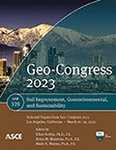Investigation of the Biopolymer Rhizobium tropici for Use in Soil Improvement
Publication: Geo-Congress 2023
ABSTRACT
The effectiveness of the biopolymer Rhizobium tropici for use a soil additive to improve vegetation drought resistance is described. Rhizobium tropici (ATCC 49672) is a gram-negative, aerobic, rod-shaped bacterium that attaches to plant roots and is responsible for nitrogen fixation. The bacterium uses plant sugars to produce an extracellular polymeric substance (EPS), or biopolymer that can form a hydrogel. The EPS was produced using 111 Rhizobium X Medium (ATCC). The structure of the biopolymer was observed using SEM cryo-microscopy imaging. Dependencies of the spatial properties of the gel network were observed. Hydrogel structures with coiled structure providing reinforcement and a bimodal distribution of mesh sizes were typical. The bulk soil properties of plastic limit and compactibility were measured for biopolymer modified and non-biopolymer amended soils, and the presence of biopolymer in these systems resulted in changes to these properties. The change in the bulk soil property compactibility resulting from biopolymer amendment showed significant changes at biopolymer loading rates as low as 0.0025% by dry weight. The hydroscopic property of the biopolymer hydrogel was observed through thermogravimetric analysis to show a fraction of strongly adsorbed water. Modification of the bulk soil properties plastic limit and compactibility using biopolymer indicate that this biopolymer may be well suited to improve slope stability, surface erosion resistance, and vegetation drought resistance.
Get full access to this article
View all available purchase options and get full access to this chapter.
REFERENCES
ASTM International. 2017b. Standard Test Method for Liquid Limit, Plastic Limit, and Plasticity Index of Soils. ASTM D4318-17. West Conshohocken, PA: approved June 1, 2017.
ASTM International. 2021. Standard Test Method for Laboratory Compaction Characteristics of Soil Using Standard Effort (12,400 ft-lbf/ft3 (600 kN-m/m3)). ASTM D698-12 (reapproved 2021). West Conshohocken, PA: approved July 1, 2021.
Busby, R., Martin, W. A., Medina, V. F., Seman, P. M., Hiemstra, C. A., Mishra, U., and Larson, T. C. 2017. Sustainable carbon dioxide sequestration as soil carbon to achieve carbon neutral status for DoD Lands. US Army Engineer Research and Development Center Vicksburg United States, 2017.
Chang, I., Lee, M., Tran, A. T. P., Lee, S., Kwon, Y. M., Im, J., and Cho, G. C. 2020. “Review on biopolymer-based soil treatment (BPST) technology in geotechnical engineering practices.” Transportation Geotechnics 24: 100385.
Larson, S. L., Ballard, J. H., Griggs, C. S., and Nestler, C. 2010. An Innovative Non-Petroleum Rhizobium Tropici Biopolymer Salt for Soil Stabilization. ASME 2010 International Mechanical Engineering Congress and Exposition. DOI: https://doi.org/10.1115/IMECE2010-38933.
Larson, S. L., Newman, J. K., and Nestler, C. 2012. Biopolymers as an Alternative to Petroleum-Based Polymers for Soil Modification. DOI: https://doi.org/10.13140/RG.2.1.3007.4085. US Army Engineer Research and Development Center Vicksburg United States, 2012.
Larson, S., Nijak, G., Corcoran, M., Lord, E., and Nestler, C. 2016. Evaluation of Rhizobium tropici-derived Biopolymer for Erosion Control of Protective Berms. Field Study: Iowa Army Ammunition Plant. US Army Engineer Research and Development Center Vicksburg United States, 2016.
Larson, S., Martin, W., Şengör, S., Wade, R., and Altamimi, F. 2021. Amendment For Increased Methane Production Rate In Municipal Solid Waste Landfill Gas Collection Systems. Science of The Total Environment, Volume 772, 145574, ISSN 0048-9697, https://doi.org/10.1016/j.scitotenv.2021.145574.
Nestler, C., Larson, S., Martin, W., Wade, R., and Hudson, R. 2016. Technology Transfer of Biopolymer Soil Amendment for Rapid Revegetation and Erosion Control at Fort A.P. Hill, Virginia. US Army Engineer Research and Development Center Vicksburg United States, 2016. https://doi.org/10.13140/RG.2.2.24733.72161.
Ringelberg, D. B., Cole, D. M., Foley, K. L., Ruidaz-Santiago, C. M., and Reynolds, C. M. 2014. Compressive strength of soils amended with a bacterial succinoglycan: effects of soluble salts and organic matter. Canadian Geotechnical Journal, 51(7), pp.747–757.
Information & Authors
Information
Published In
History
Published online: Mar 23, 2023
Authors
Metrics & Citations
Metrics
Citations
Download citation
If you have the appropriate software installed, you can download article citation data to the citation manager of your choice. Simply select your manager software from the list below and click Download.
